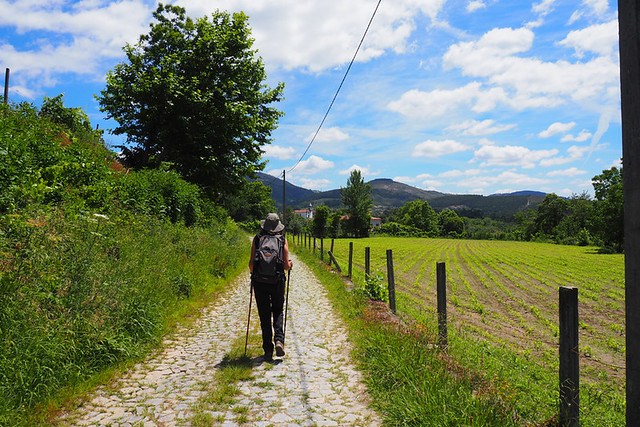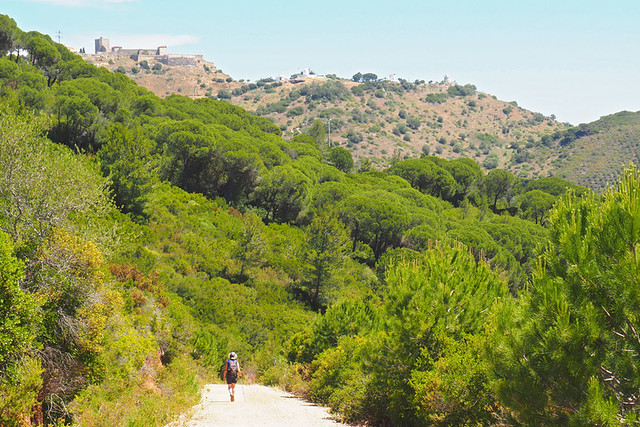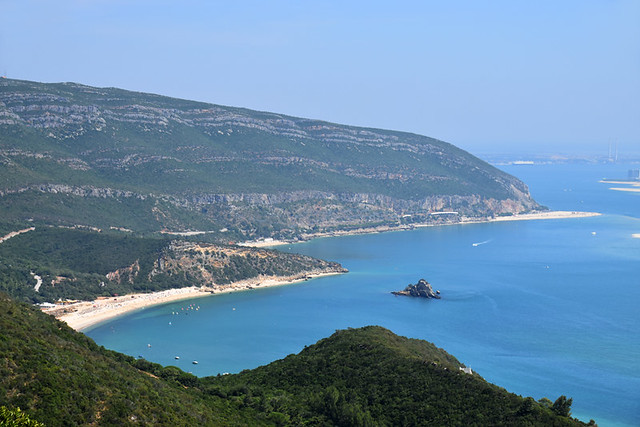“Bom dia,” the woman smiles at us. She leans on the granite window frame of a traditional farm labourer’s cottage, watching inquisitively as we stroll through the tiny hamlet.
“Little does she know we might be harbingers of a mini invasion,” Andy ponders. “Today, two British walkers are a curiosity. In a year, foreign walkers on these lanes could be the norm.”

This thought gnaws at my brain as we continue walking along the pretty cobbled lane; a hedgerow with a motley crew of wild flowers on one side, a neatly ploughed field on the other. We’ve meandered along a few of these lanes over the last couple of days, route-finding our way through anonymous hamlets, passing only a handful of locals but not one other hiker. When we asked at our hotel about walking routes in the area, the receptionist directed us to some a 20 minute drive away. They never mentioned the path we’re following, even though it was the local council’s website which drew our attention to its existence.
Two weeks previously we’d done some pre-trip training by stretching lazy muscles on a trail around Portugal’s Arrabida Natural Park, walking below windmills to climb through a valley of vines and olive groves into the welcoming, shady embrace of the forest. Whilst we encountered a local family out on a stroll, and a couple of joggers, we passed only one other pair of walkers. We knew they were British before we drew level with them. In fact, we even knew why they were there. Familiar looking documents hung around the neck of one – walking directions we’d written for an Inntravel holiday.

A couple of weeks before, on a different route in Arrabida, we’d bumped into a couple at a picnic zone. One of them also had the same documents hanging around their neck. They were the only walkers we encountered that day. These were paths where, until this spring, we’d rarely passed anyone who wasn’t Portuguese.
I thought about them and the quiet lane we were walking along. Doubts about what we were doing crept into my mind, partly fuelled by increasing reports of overtourism in some parts of Europe.

Clearly a few walkers in a rural village are not on the same scale as hordes of excursionists clogging historic city streets in places like Venice and Dubrovnik. Nevertheless, it felt as though we might be violating the Prime Directive. If anything, a few walkers in a sleepy hamlet stand out far more than visitors in a bustling metropolis.
We mulled this over as we walked.
In a few days the Portuguese summer holidays are due to start. People from all over Portugal will flock to the beaches of Arrabida. So many, Setubal council closes the coastal road leading to them until mid September when the holidays end, and the beaches empty. In past years cars, virtually dumped along this road, have impeded fire trucks and ambulances. Now, access is exclusively by bus. It’s an army of visitors with one objective, getting prone on the beach. They ignore the natural attributes of the verdant slopes behind. Ignore to the point that walking routes which had existed at one point haven’t been maintained. Until this year, stumbling across a faded waymark felt like finding treasure. Last time we walked in Arrabida we spotted freshly painted waymarks where there had previously been none. Coincidence or cause and effect?

When we talk to owners of small hotels and restaurants in any destination the consensus is unanimous. They want the sort of visitor who respects the countryside, is interested in the culture, dines in local restaurants and buys produce in village shops. These are people who put money directly into small, family businesses. And, importantly, they are there for the right reasons.
In both Porto and Lisbon I was dismayed to see jet boats, more suitable for riding rapids, and hippo boats. I’m sure they’re loads of fun in the right context, but they grate in a city scope. I don’t visit a city expecting white-knuckle river trips; I have concerns about the sort of visitor who does. However, it’s wrong to blame tourists for all the problems some destinations are experiencing. That responsibility lies with authorities who have marketed a location a certain way, or opened their ports to too many cruise ships.

A few nights before we took to the cobbled lanes, we sat in a small mountain village chatting over dinner with restaurant owner Pedro. He’d lived in New York and had an outward looking philosophy regarding life and business. His restaurant was as traditional as they come, but with a savvy approach and a commitment to total quality. As an example, instead of buying cuts of meat from the local butcher, he bought whole Cachena cattle. He did this for both consistency of the flavour of the meat and so he could use every part of it. Pedro told us there had been some resistance to tourism in the village when the first slow travellers had appeared; possibly because they signified change in a traditional way of life. But it was a change which was coming with or without tourists. Quickly the villagers realised these visitors weren’t there to transform the village, they wanted to experience local life as it was. Additionally, the money they put into local businesses helped lessen the impact of that lost by the dilution of traditional ways of work.

We’ve heard similar tales in rural locations in various countries. Low key, sustainable tourism is good for these communities, especially when it helps preserve them.
This is the conclusion we arrive at anyway; one which helps assuage any feelings of guilt. We turn a corner, guided by a barely discernible olive and white waymark. Directly ahead is an impenetrable Sleeping Beauty-esque thicket of brambles. There was a path through it once, it’s long since been devoured by nature.

We have to backtrack, sheepishly passing, again, the old woman leaning out of her window.
We don’t have to worry about breaking the Prime Directive here, she won’t be seeing any other foreign walkers passing this way anytime soon.




Be the first to comment